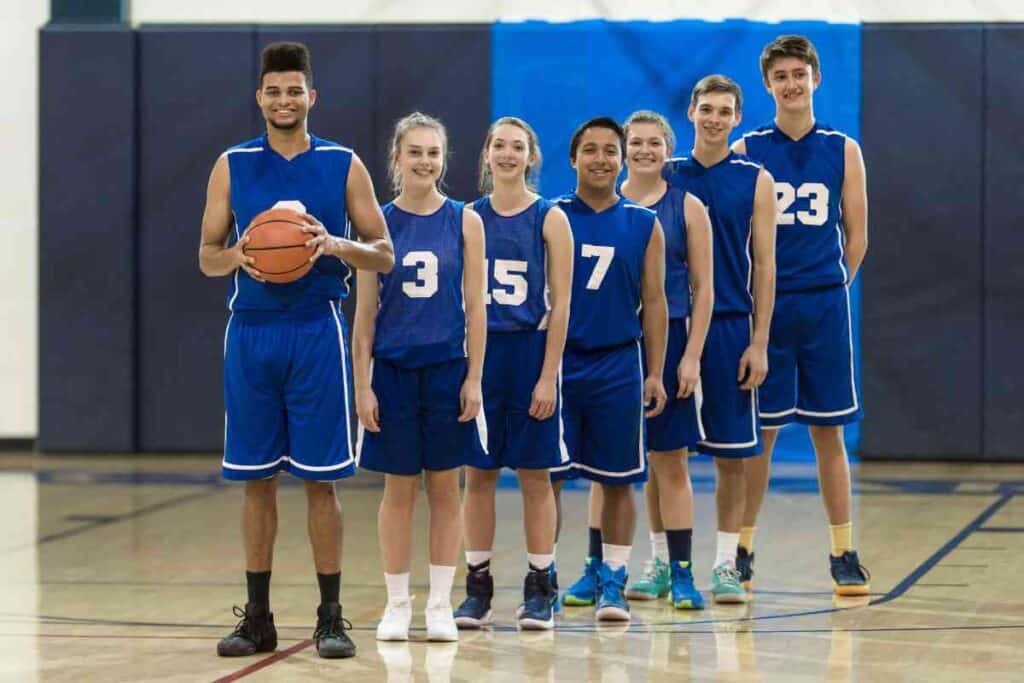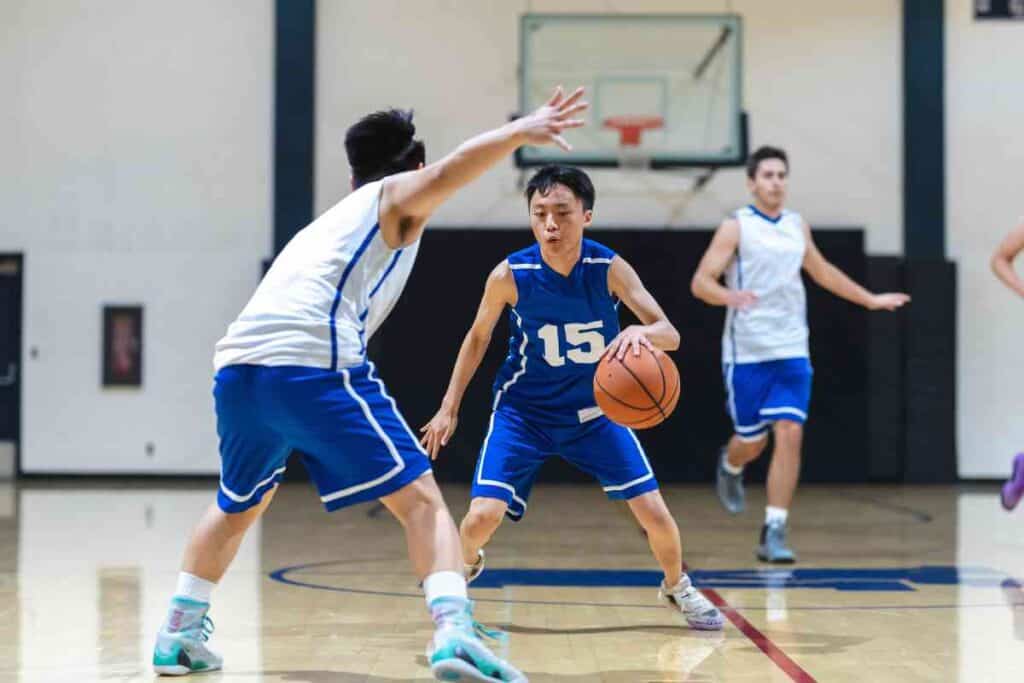The Illegal Numbers In High School Basketball & Why They’re Banned
Why are specific numbers not allowed in high school hoops games? The answer is more about the scoring table and the communication with a referee than anything.

What numbers are illegal in high school basketball?
High school basketball players may wear 00, 0-5, 10-15, 20-25, 30-35, 40-45, and 50-55 (0 and 00 are not both allowed on team rosters. Since a ref signals to the official scorer the jersey number of a player who commits a foul with their hands, the numbers are limited to make it easier for the scorer.
Basketball is a complicated game that requires effective communication between a referee and an official scorer. While refs constantly look for fouls, scorers must keep track of who scores what and who fouls whom. It can be a complicated process keeping all the players apart, even with basketball jersey numbers emboldened on their chests.
Keeping up with every play and every number is a monumental task, even for the best of mathematicians, which is one reason only specific numbers are allowed in high school basketball.
If you have ever wondered why you never see a jersey with a 6, 7, 8, or 9 number in high school or college basketball, keep reading. We have the answers you seek.
What Numbers Are Illegal In High School Basketball?
NCAA regulations (Rule 1, Section 22, Article 7, Clause b.2) prohibit high school and college basketball players from wearing specific numbers on their jerseys. The numbers allowed are 0 or 00 (not both on the same team), 0-5, 10-15, 20-25, 30-35, 40-45, and 50-55.
This regulation means that any number involving a 6, 7, 8, or 9 in the ones or tens place is not allowed and is considered an illegal number.
Why Are 6, 7, 8, or 9 Not Allowed As Jersey Numbers?

The reason for the ban has to do with the kind of communication that occurs between the referees and the official scoring table.
When a player commits a foul, the player’s jersey number must be communicated to the scorer. The ref whistles the play dead, walks toward the scorer’s table, and flashes the number of the offending player with his hands. Since there are only five fingers on each hand, it makes sense that the number cannot be above 55, or the combination cannot contain the numbers 6, 7, 8, or 9.
For example, assume that a player wearing number 6 commits a foul on another player, and the ref comes over to the table, flashing five fingers on the right hand and a single finger on the left. How can a scorer know if the offending player is number 6 or 51? The confusion over the number would slow the game down and make record-keeping a nightmare.
The practical reality for high school and college basketball programs is that there are only 37 numbers that players can choose for their jerseys.
(This is not a problem because per NCAA regulations, only 15 players can be on a college team, with only 13 allowed to suit up and play in a game).
Since players wear the same number during their years of eligibility, and new players graduate every year, there are always new numbers that can be worn at the start of a college basketball player’s career.
Many college basketball programs retire players’ jersey numbers in honor of the individual contribution that the individual has made or in memoriam for their untimely death. However, some schools like Kentucky still allow retired numbers to be worn by current players.
Other schools like Kansas have never retired a number. Duke has the most retired numbers at 13, allowing a current player to wear a retired number only twice in its long history.
Do the Pros Allow Banned Numbers To Be Worn?

NBA players are allowed to wear any number from 00 – 99.
However, the number 69 is not allowed due to the sexual implications it has. (Dennis Rodman moved to Dallas in 2000 and requested to be able to wear the number. His request was denied, and he was assigned no. 70).
The WBNA has rules that follow the NFHS and NCAA regulations, meaning that no nothing over 55 is considered to be legal numbers, although the digits 6 – 9 are allowed to be displayed.
None of the following jersey numbers have ever been worn: 58, 59, 64, 69, 74, 75, 78, 79, 80, 82, 87, and 97. In addition, most players want to retain the same number they wore in college, so there aren’t too many jerseys with numbers over 55.
If a player wants to wear a number, but it is retired by the organization, the player must write to the retired veteran and request to be allowed to wear the number.
In the history of NBA, players have worn what might be considered illegal numbers in high school or college. Kobe Bryant wore 8 for ten years (1996 – 2006) and 24 from 2006 until his retirement in 2016. Bill Russell wore no. 6 (the only jersey number retired throughout the NBA).
Some of the other numbers Wilt Chamberlain wore 13, Kareem Abdul Jabbar wore Shaquille O’Neal wore four different numbers during his career.
Magic Johnson wore no. 32 for the Lakers, and Michael Jordan wore no. 23 for the Chicago Bulls and Washington Wizards, but none of these would have been illegal numbers in the high school and college ranks.
Can the Two High School Players Wear Identical Numbers?
It is illegal for two players to be assigned the same number if they play on the same team.
Should two players wear the same number and the error is discovered after the ten-minute start of the game, this is considered a violation. The second player on the rosters list is considered the offending party by wearing an illegal uniform, the team is charged with a technical foul, and the offending player is not allowed to participate because the scorer cannot change any roster number after the ten-minute mark.

Can A Head Coach Assign the Same Number To Two Players?
According to the rules, jersey numbers cannot switch from player to player, even if they play on separate teams (varsity vs. junior varsity).
It is against the rules for two players to wear the same number – no exceptions. This rule means that even if one player is on the varsity and the other plays on the JV squad, coaches must assign both players a different number.
Who Makes The Rules For High School Hoops?
High school basketball games are governed by rules that the National Federation of State High School Associations has established. The NFHS governs the regulations for sports (both girls and boys) in all 50 states and the District of Columbia.
There are about almost 20,000 member schools that use the rules put in place by the NFHS. The general acceptance of this rule book allows for consistency in how games are played and officiated throughout the season.
The rules are precise for what can be displayed on a jersey and who can wear one. Some of the rules that apply are;
- The number on the front of the jersey must be at least 4 inches tall.
- Numbers must be plain Arabic numerals and have the same style and color as the number on the back of the jersey.
- The numbers must be one solid color (although a contrasting color can be used for the border around the digit.
- The numbers must be in a contrasting color to the background color of the jersey.
- The front of the jersey must have the school’s name or nickname, mascot name, or abbreviation of the school’s name. The location must be above the jersey number.
- All team members must wear the same color jersey as the rest of the team members on the court.
- Two teams will not be allowed to play the same game with the same colored jerseys.
Key Takeaways
- For high school basketball, no jersey number can be over 55 or include the numbers 6, 7, 8, or 9.
- The numbers 0 or 00 are allowed but cannot be rostered on a team.
- No jersey number can be swapped by participants playing at any time.
- No jersey number can be changed by the official scorer after the ten-minute mark.
